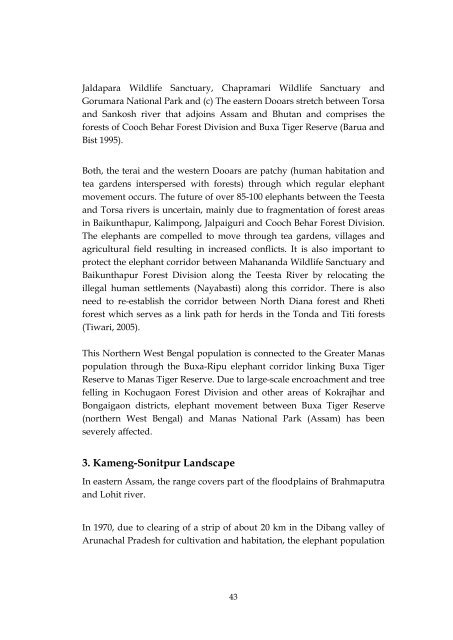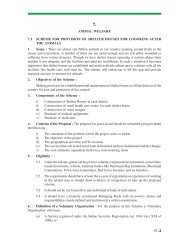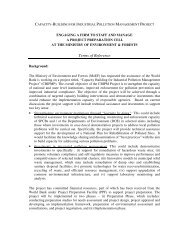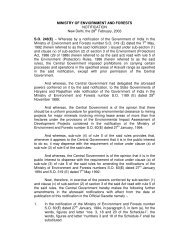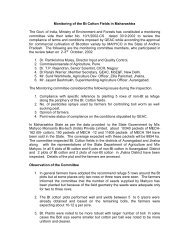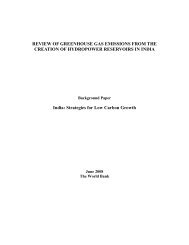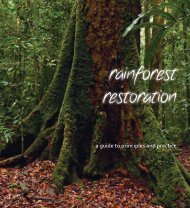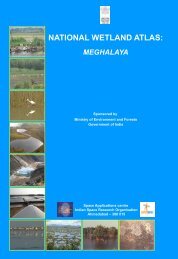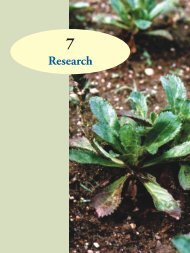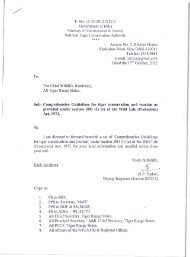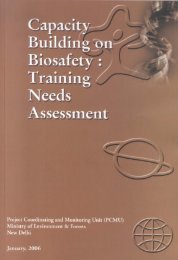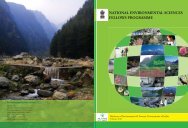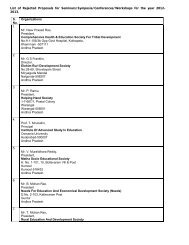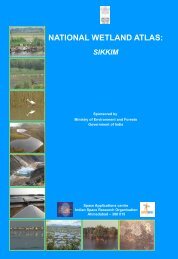Securing the Future for Elephants in India - Ministry of Environment ...
Securing the Future for Elephants in India - Ministry of Environment ...
Securing the Future for Elephants in India - Ministry of Environment ...
You also want an ePaper? Increase the reach of your titles
YUMPU automatically turns print PDFs into web optimized ePapers that Google loves.
Jaldapara Wildlife Sanctuary, Chapramari Wildlife Sanctuary and<br />
Gorumara National Park and (c) The eastern Dooars stretch between Torsa<br />
and Sankosh river that adjo<strong>in</strong>s Assam and Bhutan and comprises <strong>the</strong><br />
<strong>for</strong>ests <strong>of</strong> Cooch Behar Forest Division and Buxa Tiger Reserve (Barua and<br />
Bist 1995).<br />
Both, <strong>the</strong> terai and <strong>the</strong> western Dooars are patchy (human habitation and<br />
tea gardens <strong>in</strong>terspersed with <strong>for</strong>ests) through which regular elephant<br />
movement occurs. The future <strong>of</strong> over 85-100 elephants between <strong>the</strong> Teesta<br />
and Torsa rivers is uncerta<strong>in</strong>, ma<strong>in</strong>ly due to fragmentation <strong>of</strong> <strong>for</strong>est areas<br />
<strong>in</strong> Baikunthapur, Kalimpong, Jalpaiguri and Cooch Behar Forest Division.<br />
The elephants are compelled to move through tea gardens, villages and<br />
agricultural field result<strong>in</strong>g <strong>in</strong> <strong>in</strong>creased conflicts. It is also important to<br />
protect <strong>the</strong> elephant corridor between Mahananda Wildlife Sanctuary and<br />
Baikunthapur Forest Division along <strong>the</strong> Teesta River by relocat<strong>in</strong>g <strong>the</strong><br />
illegal human settlements (Nayabasti) along this corridor. There is also<br />
need to re-establish <strong>the</strong> corridor between North Diana <strong>for</strong>est and Rheti<br />
<strong>for</strong>est which serves as a l<strong>in</strong>k path <strong>for</strong> herds <strong>in</strong> <strong>the</strong> Tonda and Titi <strong>for</strong>ests<br />
(Tiwari, 2005).<br />
This Nor<strong>the</strong>rn West Bengal population is connected to <strong>the</strong> Greater Manas<br />
population through <strong>the</strong> Buxa-Ripu elephant corridor l<strong>in</strong>k<strong>in</strong>g Buxa Tiger<br />
Reserve to Manas Tiger Reserve. Due to large-scale encroachment and tree<br />
fell<strong>in</strong>g <strong>in</strong> Kochugaon Forest Division and o<strong>the</strong>r areas <strong>of</strong> Kokrajhar and<br />
Bongaigaon districts, elephant movement between Buxa Tiger Reserve<br />
(nor<strong>the</strong>rn West Bengal) and Manas National Park (Assam) has been<br />
severely affected.<br />
3. Kameng-Sonitpur Landscape<br />
In eastern Assam, <strong>the</strong> range covers part <strong>of</strong> <strong>the</strong> floodpla<strong>in</strong>s <strong>of</strong> Brahmaputra<br />
and Lohit river.<br />
In 1970, due to clear<strong>in</strong>g <strong>of</strong> a strip <strong>of</strong> about 20 km <strong>in</strong> <strong>the</strong> Dibang valley <strong>of</strong><br />
Arunachal Pradesh <strong>for</strong> cultivation and habitation, <strong>the</strong> elephant population<br />
43


